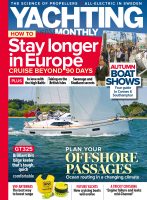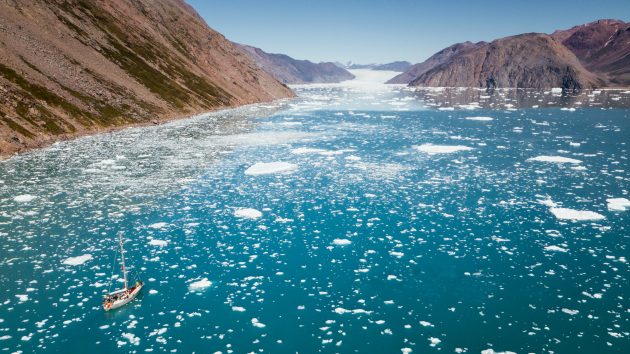Tobias Carter launched the Unu Mondo project to document climate change in the Arctic. His article was runner-up for the 2022 Brian Black Memorial Award
The north face of our planet is literally changing colour. As the Arctic Ocean loses sea ice, it turns large areas from white to dark blue. At the same time, the land loses snow coverage for longer and longer periods every summer, going from snowy white to brown then greens, with the tree line creeping further north every year.
Maybe with recent heatwaves, melting airport runways and buckling railways, climate change is starting to catch up with a few of us, but it is still viewed by many as a distant and uncertain threat.
The Arctic is warming three times faster than the global average. This is what made me sail there in the summer of 2020, despite an ongoing global pandemic. The climate would not wait, nor would I or my newfound crew.
The plan was simple: sail to Greenland to gather testimonies on climate change from scientists and local communities. We would also act as a logistical platform for research projects while filming and interviewing with our onboard media crew.
There were, however, many issues with this plan. I had first launched this project, Unu Mondo, with Sophie Simonin in June 2019. Together we had no money, under a year to prepare, a Swanson 36 in bad nick and no high-latitude sailing experience. I was the more experienced sailor of the two and had only been sailing for three years!
To top it off, four months before our planned departure, we purchased a 47-footer on the dry with a cracked hull and recruited four crew (media and scientists) of which three had virtually no sea experience whatsoever.

En route to Greenland on Northabout. Photos: By crew / Thomas Bour, Julien Fumard, Michael Fonder
Greenland here we come!
Madness, you say! Well, the whole project really came together strangely enough on 30 January, 2020 when we signed to buy that sinking ship. Her name is Northabout, a Nadja 15 designed by Gilbert Caroff and built in Westport, Ireland by explorer Jarlath Cunnane, who went on to circumnavigate the Arctic aboard her from 2001 to 2004. In 2016, Northabout became the only vessel to have circumnavigated the Arctic twice after completing the Polar Ocean Challenge, led by Sir David Hempleman-Adams. She is a well-built expedition-style vessel, designed for the north, with the history, bumps and bruises to prove it.
After four months of work to get her afloat, and with the mast pointing the correct way, we sailed out of Avonmouth on 2 June, 2020, well behind schedule. The boat was in sailing order but far from ready for our upcoming ocean crossing.
Our first destination was Saint-Malo, France, to pick up crew and equipment. Greenland was then Covid-free, we had permission to travel there thanks to our scientific partners but we still had to make triple-sure we were germ-free. Believe it or not, Sophie, who had had no symptoms, tested positive the day before our planned departure. Another 14 days locked up on our boat would be necessary before we could finally get on our way.

On 6 July, we left the port of Roscoff for a non-stop sail to Greenland. We headed north, despite only having had three days sailing experience aboard Northabout. The worst part for me was not the full force of the storm that would hit us, but the experience two days earlier when we started bashing into 25 knots with the seas building, then we started looking at the GRIB weather files and the crew got quieter and quieter.
To make it worse, we had started taking on water, a lot of water. The bilge pumps were coping, but something was very wrong. It was day six and we were already 250 miles off Ireland’s west coast. It took me a few hours but I eventually found the issue. There was no anti-return valve on the starboard bilge pump. As we lunged into wave after wave, it was filling our bilges instead of emptying them! An easy fix, but ‘wow’, the thought of your ship being torn to pieces by the upcoming storm in the middle of the North Atlantic does put a man in his place.
After 14 days we laid anchor at the entrance of the famous Prince Christian Sound in southern Greenland. This voyage was an entire year in the making and working flat out, we had done it! Covid didn’t stop us, nor the leaky boat, we could finally get to work on our mission.

Deploying a drifting buoy for weather research. Photos: By crew / Thomas Bour, Julien Fumard, Michael Fonder
Starting the mission
We started by befriending Greenlanders in the biggest southern town of Qaqortoq, where we found Eric who agreed to accompany us to more remote villages and help translate during interviews.
My background in construction did help me become a decent sailor by understanding quickly how to maintain and keep a boat functioning. However, that did not help me with the new part of my job – becoming a YouTuber! I had to understand this foreign environment while trying to share what we were learning by publishing a video every two weeks or so.
Climate change affects Greenlanders’ culture, jobs and way of life in diverse ways. Hunters have less sea ice to move on and are forced to borrow money to buy boats and become fishermen. The fishermen told us they are seeing new species including tropical sharks. Ayu, a local geologist, told us that retreating glaciers and less sea ice mean more mineral deposits are becoming accessible and easier to exploit. Tourism is booming as the world wants to come to see the bears and glaciers before they’ve gone. Even archaeologists there told us how their work is now a race against time.

Northabout approaching Greenland. Photos: By crew / Thomas Bour, Julien Fumard, Michael Fonder
Warning the world
While it is true that the Greenlanders are seeing much more change than we are, I did not travel north to help the peoples of the Arctic – they will adapt. We need to worry about the countries that will not adjust so fast. This includes western Europe: we are not prepared to handle the changes to come. What happens in the Arctic will not stay in the Arctic.
I slowly got better at talking in front of a camera and interviewing scientists; the summer was going well. The crew were getting along and working great together – just as well, as we were working flat out and under constant pressure. The only remaining issue was our key scientific objective of installing the three weather stations, not to mention the sail home.

Crew members are ready for the Arctic. Photos: By crew / Thomas Bour, Julien Fumard, Michael Fonder
Covid had impacted the delivery date of the weather stations. We finally picked them up in the town of Narsaq in southern Greenland on 1 September – when we should have been sailing home. The crew didn’t like that so much.
We were tired, inexperienced and the days were getting darker and colder – time was not on our side. The Refleks stove was keeping us warm on the yacht, or at least those of us lucky enough to be sleeping in the back cabins. There was nothing to be done about the light or heat for the poor sods sleeping up front, apart from decent sleeping bags.

The small town of Narsaq. Photos: By crew / Thomas Bour, Julien Fumard, Michael Fonder
The first weather station was to be installed on an island not far from the town of Nanortalik in the south. We lost no time and despite the harsh weather, we sailed straight there, choosing the narrow and tricky fjords to move east rather than face the rough open seas.
Hard slog
It took us a gruelling 11 hours in the cold and damp, carrying everything up the chosen hill, to install the first one. The entire crew pulled together to carry, build and film the entire process. One down, two to go. We now knew how to do it and the second installation was completed in just seven hours.
All was going well except for one thing: the weather. The stable weather windows were over. The coast was getting hammered by a new storm every 48 to 72 hours, which was not long enough to make enough track to the southwest to get out of the direct path of the next one coming up.

Loading 4,000 trees on deck for planting. Photos: By crew / Thomas Bour, Julien Fumard, Michael Fonder
It took us another three days to relocate to the final site and complete the third and final installation in a glacial valley off the Prince Christian Sound. We had accomplished all of our objectives, now we just needed to get home.
As the number of depressions that year exceeded the number of letters in the alphabet, we waited and prepared in the small village of Aappilattoq, also in the south. After a 10-day wait for a window, on 18 September, 2020, we finally left Aappilattok at 1800. As the winds dropped, we headed out and braved the dark hours and heightened risk of hitting a small growler, to make the most of every hour of the 3.5-days head start we had before the next storm came to greet us.
It took us 11 days to sail the 1,600 miles to Brest, being hit by two storms on the way. We arrived in the harbour with just hours to spare before France’s west coast got hammered by storm Alex.
The ocean is absorbing 94% of the excess heat generated by climate change. Climate change is man made. Fact. That’s good news. It means we can do something about it. I am, will you?
Read more about the Brian Black Memorial Award
Enjoyed reading this?
A subscription to Yachting Monthly magazine costs around 40% less than the cover price.
Print and digital editions are available through Magazines Direct – where you can also find the latest deals.
YM is packed with information to help you get the most from your time on the water.
-
-
- Take your seamanship to the next level with tips, advice and skills from our experts
- Impartial in-depth reviews of the latest yachts and equipment
- Cruising guides to help you reach those dream destinations
-
Follow us on Facebook, Twitter and Instagram.





